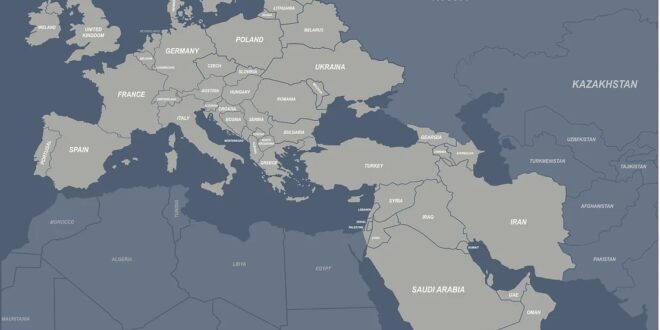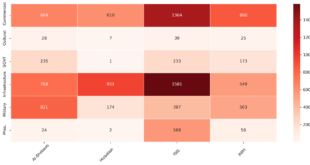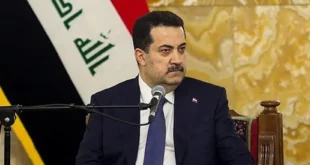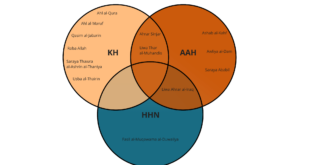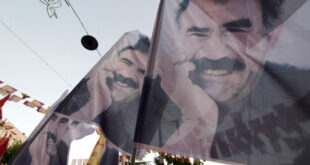Abstract: This paper deals with the question of the extent to which a security partnership between European and the Arab states increases mutual security on the one hand, and on the other hand, how such cooperation affects the development of the Arab developing states. Finally, it asks whether a new relationship of trust can grow between the two different cultures after a difficult historical “journey.”
Bottom-line-up-front: Security policy cooperation usually leads to mutual benefit, as the examples of NATO or the EU show. This does not only apply to the security sector but also the socio-economic sphere.
Problem statement: Can a security partnership between the European states and the Arab countries be profitable for the security structure as well as for the socio-economic development between Orient and Occident?
So what?: Particularly because of the steadily increasing migration movements from the Arab diaspora and the partly unclear security determinants that go hand in hand with this, the EU and Europe as a whole should approach the Arab states and promote a Mediterranean Union in the form of a security partnership.
A Theory of Military and Security Thought from the 19th Century to the Present to Understand a Necessary Security Partnership between Europe and the States of the Arab World
The latest war scenarios in the Middle East and the associated strategic implications for the EU and its security interests make it imperative to define the terms “strategy” and “operation” more precisely. Already Herfried Münkler, in his 2006 book: Wandel des Krieges, points out that the traditional idea of symmetrical war, which is still partly common, would be replaced by asymmetrical forms of war. In his definition of symmetrical and asymmetrical forms of war, Herfried Münkler assumes that in symmetrical conflicts forces of equal strength usually clash. This means that the traditional image of war comes into play here, namely that two military opponents or coalitions are in a confrontation that have roughly the same material and immaterial strength. In his book Rise and Fall of the Great Powers, Paul Kennedy argues that the great powers in history had to have both the necessary economic strength to convert it into military manpower in symmetrical conflicts. An example of a current symmetrical conflict is the war in Ukraine.
This means that the traditional image of war comes into play here, namely that two military opponents or coalitions are in a confrontation that have roughly the same material and immaterial strength.On the other hand, asymmetric conflicts are characterised by the fact that a weak military opponent, who is above all technologically inferior, disrupts a technologically and economically superior opponent by attacking civilian infrastructure. Through the media’s portrayal of such events, the weaker adversary may even gain traction, while the technologically superior adversary runs the risk of having its societal base hit both psychologically and economically in such a way that it could be paralysed for a longer period of time. The best example that can be cited here is September 11, 2001, with the attacks in the USA.
These two types of war partly overlap in strategy and tactics, as shown since 2010/11 by the theaters of war in Mali, Libya, Syria, Iraq and partly in Lebanon. It is precisely the changes in the geopolitical and military landscape of the Arab region that make it necessary to form strategic partnerships. The following analysis of the changing terminology and reality of “operations” and the resulting changes in strategy forms the basis for the author’s assessment that today’s political and military realities require a strategic security partnership between Europe and the Arab League states so that the two regions can achieve mutual security and socio-economic development of the Arab states involved.
The Evolution in Operations
In recent centuries, the concept of what constitutes “operations” has changed significantly. Herfried Münkler rightly points out that due to the changes in the image of war away from symmetrical forms to asymmetrical types of war, the forms of operations in the military sense have also changed. This is especially true with the beginning of the age of nuclear war, the Cold War, and the associated proxy wars, in which asymmetric operations could be cultivated.[1] It should be clear that the concept of operation already in the Napoleonic wars always implied the space and time continuum as part of modern warfare in which the alliance of all weapons was focused.[2] Moltke the Elder paraphrased this with the credo: March separately, strike together.[3] An operation does not have to be limited to the battlefield but can encompass the entire war zone. According to Moltke’s diction, it is always a matter of seeking a military decision to bring the war scenario to a swift end.[4]
In Germany, the historical context then gave rise to the Bundeswehr Directive HDv 100/900 of 1977, in which the term “operation” in the sense of command and control was considered in greater detail.[5] Globally, in the 21st century, an “operation” is considered a military action that is limited in time and spatially focused on a specific objective. Every form of armed movement, including combat operations and other actions, is included under the term operation in the military sense.[6] As early as the 19th century, people spoke of military operations that had the purpose of carrying out military thrusts far into the depths of the enemy’s space, which is why the word operation was often used in this sense.
The Inner and Outer Lines of Operations
Operations, in general, can be conducted both on the inner and outer line of operations. This depends on the respective spatial disposition. The inner line of battle is the line of battle that mostly exploits the narrow space; for example, in the Battle of Tannenberg in 1914, Hindenburg and Ludendorff exploited the narrow space to encircle the Russian army. The outer line of battle is the line of battle that mostly exploits the wide space to threaten the enemy in the flanks. The best example here is Napoleon’s victory in the Battle of Austerlitz. The inner and outer battle line thus depends on the respective spatial disposition.[7]
The inner line of battle is the line of battle that mostly exploits the narrow space; for example, in the Battle of Tannenberg in 1914, Hindenburg and Ludendorff exploited the narrow space to encircle the Russian army. The outer line of battle is the line of battle that mostly exploits the wide space to threaten the enemy in the flanks.According to an article in the Neue Züricher Zeitung (02/20), Europe is currently in the geostrategic position of the Inner Line, which stretches from the Bosporus to the western end of the Mediterranean. The threat arises from the partially collapsed state structures from the Middle East and the Maghreb. This is the breeding ground for the asymmetric warfare of international terrorism, which uses these disrupted structures largely to further its paramilitary activities through migration flows. We see this, for example, in the actions of individual perpetrators, like recently in Nuremberg. Heinrich Berenhorst wrote on both terms in the course of the Napoleonic wars and the insights gained from them in the 19th century – that strategy was the momentum of marching and tactics, the momentum of striking the enemy.[8] In view of the dynamics of the constantly changing situation in the states of the Arab League, but also in West Africa, Europe as a whole is therefore called upon to adapt its security strategy as it did in the 19th century, namely to confront the evolving threats together and, if necessary, to intervene militarily or to seek a partnership with the states of the Arab League. It should be noted that those states of the EU also involve the states that do not belong to the EU, because in questions of security and the fight against terrorism, the whole of Europe as well as the entire Arab region is affected. On the one hand, this can help rebuild the disintegrated structures of the Arab diaspora, and on the other, it can provide support in the fight against international terrorism.
Strategy Above Tactics
Clausewitz, however, in his well-known work “On War” sees strategy as a superior determinant to tactics.[9], [10] Tactics are thus the use of armed forces in battle, while strategy is the sum of the battles for the purpose of war.[11] In his theory, there is basically an end-means relationship[12] and thus a dependency between tactics and strategy, both terms being thought of as belonging together.[13] In this context, political action plays an essential role because it would permeate the entire warlike conflict.[14] This insight, which Clausewitz once coined, is particularly essential for Europe and the connection to the Arab states, especially since Bassam Tibi points out that the armed conflicts in the Islamic world necessitate political action on the part of Europe from a military policy point of view and that this also permeates the military conflict structures. However, the Arab counterpart is also politically challenged to bring the conflicts to an end and possibly to strategically clarify the security issues on this site and the other side of the Mediterranean in a partnership with Europe. Joint naval operations might also be helpful in this regard. While Clausewitz presents war as a political theorem, Jomini goes more into the practice because he asks: How does one wage war? Jomini sees strategy as the foundation for actually grasping the theatre of war, i.e. the space, to act effectively militarily.[15] Jomini, therefore, deliberately leaves out political as well as social variables of warfare. War is, therefore, always also a political event in which social as well as political security interests are subsumed.
While Clausewitz presents war as a political theorem, Jomini goes more into the practice because he asks: How does one wage war?The Application
Especially for the Bundeswehr and other European armies, such joint operations would be necessary to get out of the already described inner line. This would also be essential because European political actors will most likely have to intervene more frequently in these areas in the future, and this will challenge the concept of tactics anew, which is why strategic partners are also needed, especially in the Arab states.[16] Flavien Bourrat and Bassam Tibi point out that in the Arab-Islamic world, the military and security apparatuses often form a state within the state. Often, they are even the foundation of “deep states” in which the military structures absorb the political ones.[17] The best examples of this are Egypt and Algeria, which have long traditions of political-military governance. In most cases, the state leaders here were and are military commanders. Where Europe broke with this tradition after World War II and World War I, the decolonisation of the Arab world and its pan-Arabist revolution under Jamel Abdel Nasser began the installation of military regimes. Most of these have persisted to this day with few transformations.
Even at the beginning of the 1950s, people were aware that, among other things, German rearmament was not only a European political or even a moral issue but especially a military one.[18] In Central Europe, it was recognised that a nuclear war would lead to the total destruction of most of Europe, so they were aware of the importance of deterrence. That is why 20th century German General Ulrich de Maizière realised in 1962 that the political, as well as military changes, would also have to lead to a transformation in operational thinking in its entirety and this with the greatest possible variability. On the one hand, these global changes began with the end of the Cold War and the emergence of international terrorism around al-Qaeda and its offshoots in Asia and Africa. On the other hand, they began with the revolutionary upheavals in the Maghreb and the Middle East starting in 2010. However, these revolutionary coup attempts were more like Flavien Bourrat military coups to maintain military-political and socio-economic power in the Middle East.[19]
The Need for European Variability in the case of the Mediterranean Crisis Regions
This insight of General de Maizière applies today more than ever, especially in the Middle East and the Mediterranean region: As has previously been explained, it was already clear to the then-Inspector General of the German Armed Forces that the Mediterranean region, and in particular the Maghreb and the Middle East, played an essential strategic role during the Cold War, especially after the numerous Israeli-Arab conflicts. It had to become clear to him that this region would remain a conflict-laden region in the long run and that this would pose a security challenge to Europe for a long time to come.[20] The recent Middle East conflict, in which Egypt ultimately played an essential mediating role, makes this clear as if through a magnifying glass.[21] Egypt has recently mediated on the Palestinian issue, not because of the Palestinian issue itself, but because of the geopolitical ambitions of President General Abdel Fattah Sissi. This dual geopolitical and military motivation is particularly evident in the foreign policy actions of Egypt and Saudi Arabia. Both interact in the civil war in Yemen, they cooperate in Libya in support of General Hafthar, and for the most part, together with Morocco, they support the military-political, partially despotic “reorganisation” of Tunisia. It is precisely these foreign policy actions of the Arab regional powers, such as Morocco, Egypt, and Saudi Arabia, that make it extremely difficult to demand security and freedom from the European Union’s perspective.
This dual geopolitical and military motivation is particularly evident in the foreign policy actions of Egypt and Saudi Arabia. Both interact in the civil war in Yemen, they cooperate in Libya in support of General Hafthar, and for the most part, together with Morocco, they support the military-political, partially despotic “reorganisation” of Tunisia.Resisting this European notion of “freedom “is the fact that, for the Arab states, the military power retains absolute control both internally and externally and therefore also tolerates external interference. General Hafthar (Libya) has already made this clear in many respects, and so have groups that are not under state supervision and even untemper the national aspirations of the Arab political-military apparatus. As has already been made clear and outlined in Bilan Géostrategique 2021, in the 2021 Moyen-Orient magazine, international terrorist organisations such as IS and the Al-Shabab militia use interregional conflicts and the associated refugee movements to destabilise Europe.
A security partnership between Europe and the states of the Arab League is essential to prevent or at least minimise destructuring within the Arab world, but also with regard to Europe, which could endanger security. Such a partnership is not new. As early as the 19th century, many European industrial goods found their way to the Middle East, mainly through trade. However, the open-door policy of the USA, in particular in the former provinces of the Ottoman Empire, shook confidence in the Western world.[22] In his book entitled El-Muchdarah (The Conspiracy), Bassam Tibi describes how, after the end of the Ottoman Empire in 1918/23, the West gambled away the trust of the Arab world piece by piece, not only because they politically reorganised the Middle East without the Arab tribes with the Sykes-Picot Agreement, after they had already colonised the Maghreb in their favour in the mid-19th century, but also because they had economically subordinated the states of the Arab diaspora to their interests.[23]
This alienating economic subordination of the region became evident at the latest in the 1930s when the race for the resources of the Islamic world began and favouritism clauses were set to the disadvantage of the Arab states. European behavior towards and within the region was bound to increase distrust in the West to the point of distancing themselves from the West. With the Algerian War and the Suez War in the 1950s, trust in Western culture (Huntington) eroded completely, especially since Jamel Abdel Nasser ushered in a new political era in the Islamic-Arab hemisphere, which had a different “national” idea of the Arab world that was completely different from the Western one.[24]
The most-favoured-nation clauses imposed on the Arab states meant that these states could not develop either economically or politically.[25] The broad mass of the population became impoverished and remained in these poor structures. Neither the Nasserist nor the Gaddafist revolutions of the 1950s and 1960s changed anything.[26] Especially in the world economic crisis of the 1930s and now in the Corona crisis, the deterioration of the terms of trade led to a deterioration of the food supply in the Middle East and thus to famines and then to bread riots.[27] This was seen in the 30s in the uprisings in Syria and Iraq against British rule, after the economic crisis in 2008 in Tunisia and partly in Egypt, which finally erupted in the “Arab Spring” in 2010/2011 and contributed to the fall of various Arab regimes. It is now partly repeated in 2021 in Lebanon, Sudan and Palestine.
The fact that imports from the Middle East to the West decreased in the 1930s as well as after the economic crisis of 2008 with the worldwide increase in inflation, which had already hit the Arab world in 2011/2012 and was duplicated by the health crisis, leads to uprisings like those of the 1930s and worse, ultimately to military conflicts on a new level.[28] Despite, or perhaps, because of, the strained interactions between the two regions in recent centuries, a partnership between Europe and the states of the Arab Diaspora would do much to rebuild mutual trust and, as has already been made clear, strengthen both security and socio-economic development for both sides. These conflicts are not only the expression of distributional struggles that could still be resolved, but in them, the clash, the bang, of the most diverse cultural insights and mechanisms is revealed.
Despite, or perhaps, because of, the strained interactions between the two regions in recent centuries, a partnership between Europe and the states of the Arab Diaspora would do much to rebuild mutual trust and, as has already been made clear, strengthen both security and socio-economic development for both sides.It is not the clash of civilisations that Huntington described with respect to the erosion of trust in Western culture. It is the clash of different understandings of leadership within the Arab region and outside it. This theory of Huntington’s, which has been strongly criticised, proves that from Mali to Libya to Iraq and beyond, different cultural attitudes and ideologies have been fighting and warring against each other in the bloodiest way since 2010 and even before, and no political solutions have been found for these intercultural and inter-ideological conflicts. It is the struggle of the elite that wants to preserve the traditions, what Jamel Abel Nasser called the pan-Arab revolution to nationalise the entire Arab diaspora from Mauritania to Sudan to Iraq. One part of the Arab power elite around the Saudi prince and despot Ben Salman and the brother of the Jordanian Hashemite king certainly want reforms, but only within a limited framework. For example, women have recently been allowed to drive in Saudi Arabia.
However, these reforms only serve to maintain power. At the same time, Ben Salman had a young blogger who criticised the royal family executed. So the so-called reformers in the Arab despots have a different idea of nationalisation, but with the same method as once used by Jamel Abdel Nasser. The group of preservers includes General Sissi in Egypt, the military junta in Algeria and finally, the military and political leadership in Lebanon, where it became clear that stagnation can lead to ruin. Especially in Lebanon and in the Palestinian enclave, as in the 1930s, it becomes clear what economic disaster entails.
Poverty is only one part of the overall social disintegration. It also increases migration within the Middle East from Morocco to the depths along the Tigris and Euphrates rivers. These population migrations also accelerate conflicts in the Arab world that reach Turkey, Iran, and Pakistan. Yemen, along with Lebanon, is the best example of this. This now disintegrated state on the Red Sea has been embroiled in a civil and proxy war since 2012, coupled with a hunger and health crisis. No state has yet persuaded the hostile parties to end the conflict peacefully. Worse still, various dogmatic terrorist offshoots have established themselves in this disintegrated region, as in Libya, for example, and the danger for the West, Europe in particular as a riparian is growing, as the coup in Mali at the end of May 2021 showed.
In Mali, as in Yemen, forces have asserted themselves to become a direct threat to Europe. Egyptian President Gen. Sissi and Tunisian President Kais recently called on Europe to enter a strategic security partnership precisely because the challenges are immense.
Conclusions
A security partnership between the EU or Europe and the states of today’s Arab League is not only in the interest of mutual security on both sides of the Mediterranean, but it may also promote the socio-economic development of these Islamic regions. This could, in turn, be the beginning of democratic structures in this region and thus lead to more stability. Even after 1945, the embedding of the Federal Republic of Germany and Italy in the security structures of the West, both NATO and the EC, has contributed to democratic stabilisation. Of course, identical democratic structures are not possible in the Orient. However, the example of Lebanon before the civil war of the 1980s and 1990s shows that democratic transformations are not utopian, especially since Lebanon was considered the “Switzerland of the Middle East” until the civil war and the current upheavals without a security partnership with European states.
A security partnership between the EU or Europe and the states of today’s Arab League is not only in the interest of mutual security on both sides of the Mediterranean, but it may also promote the socio-economic development of these Islamic regions. This could, in turn, be the beginning of democratic structures in this region and thus lead to more stability.Thus, a partnership for security and economic development may well bring about political changes that are not yet foreseeable. At the same time, however, it would perhaps also be a contribution to a new basis of trust between the Orient and the Occident, which has often been squandered in the course of history. Security, both economic and social, can only come about if there is trust between Europe and the Arab states, and at the same time if the people in Europe and the Arab states have confidence in their political and military leadership with regard to mutual support in security policy, foreign policy and development policy. Only through joint operations to strengthen mutual security interests and common strategic perspectives can it be possible to overcome cultural differences and offer “check” to international ideologised terrorism on the one hand and advance socio-economic development on the other. In this way, Europe, too, can free itself from the inner line of the strategic Middle Eastern crescent that stretches from Iran to the shores of Western Sahara. It was on the EU’s fathers, Helmut Kohl, who, shortly before his death, clearly advocated in a short work that Europe has a responsibility towards these states, which means that a strategic security partnership also offers the necessary variability in crises. This is the modern form of Heusinger’s and de Maizière’s forward strategy from the 1950s and 1960s. Just as de Maizière, in a forward-looking manner, had the importance of the Middle East in mind, so today, in the 21st century, a new forward strategy must be put on the agenda in terms of security policy when it comes to the link between the Orient and the Occident. Europe must abandon its Inner Line and move to an active strategy together with its Arab neighbors. This includes joint operations to combat, in particular, international ideological terrorism, which also calls into question the stability of the Arab diaspora. In this respect, the Arab political elites must also be interested in acting together with Europe regarding security policy. It is precisely through joint military operations that both sides also gain tactical experience on the battlefield in times of a constantly changing war scenario. This is the only way to master the military policy challenges facing both sides in the 21st century.
[1] Herfried Münkler, Der Wandel des Krieges. Von der Symmetrie zur Asymmtrie (Weilerwist, 2006), 30-36; and Herfried Münkler, Stationen der Kriegsgeschichte im Spiegel ihrer theoretischen Reflexion (Weilerwist, 2005). [2] Ibid. [3] Moltke d. Ältere, Helmuth von Moltke: Auswahl aus seinen Schriften, in: Kriegstheorie und Kriegsgeschichte, ed. Reinhard Stumpf, (Frankfurt a. Main, 1993, vol. 23). [4] J. Gerber (Ed.), Landkriegführung. Operation, Taktik, Logistik, Mittel. Ein Handbuch (Osnabrück, 1992), 549-557. [5] HDv 100/900, 1977. [6] Ibid. [7] Moltke der Ältere, Helmuth von Moltke: Auswahl aus seinen Schriften, 415-422. [8] J. L. Wallach, War Theories. Their Development in the 19th Century (Frankfurt am Main, 1972), 29-33. [9] Carl v. Clausewitz, Vom Kriege (Berlin, 2004), 22/23; and J. L. Wallach, War Theories (Frankfurt am Main 1972), 31-36. [10] In distinguishing between strategic and tactical levels, it should not be overlooked that Clausewitz distinguishes between two approaches already within strategy: he subsumes – which might be confusing particularly for the non-German speaking reader – both, overall strategic thinking for the purpose of policy advice and military command in (large-scale battle unit-) operations under his central concept of strategy, clearly defined at every point but assigned to only one and the same term, cf. Wolfgang Peischel, The Essence and Core of Military Science: An Attempt at a Definition by Means of Applying Two Dialectically Opposed Approaches, 2020, in: Wolfgang Peischel & Christoph Bilban (Ed.), Building Military Science for the Benefit of Society (Berlin: Carola Hartmann Miles-Verlag), 30-31. [11] Carl v. Clausewitz, Vom Kriege (Berlin, 2004) 22/23; and J. L. Wallach, War Theories (Frankfurt am Main, 1972), 31-36. [12] This ends-means-relationship again reveals the two approaches that Clausewitz subsumes under his concept of strategy: according to his logic, strategy, as the controlling instance of military science doctrine, would have the task of aligning, among other things, the ability to provide policy advice with the transformation of the political purpose into operational options for action, cf. Wolfgang Peischel, „Strategie“ als Kernfach, Leitdisziplin und Steuerungsinstanz, 2018, in: Wolfgang Peischel (Ed.), Wiener Strategie-Konferenz 2017 (Berlin: Carola Hartmann Miles-Verlag), 102. [13 Carl v. Clausewitz, Vom Kriege (Berlin, 2004), 22/23; and J. L. Wallach, War Theories (Frankfurt am Main 1972), 31-36. [14] J. L. Wallach, War Theories. Their Development in the 19th Century (Frankfurt am Main, 1972), 11-17; Gehard P. Groß, Mythos und Wirklichkeit. Geschichte des operativen Denkens im deutschen Heer von Moltke d. Ä. bis Heusinger, ed. by Militärgeschichtliches Forschungsamt, vol. 9, (Paderborn, 2012), 9-25. [15] Ibid. [16] “NATO 2030,” Erfahrung, Herausforderung, Zukunft, published by the German Atlantic Society, (Berlin 2021). [17] Bassam Tibi, Militär und Sozialismus in der Dritten Welt (Frankfurt am Main, 1973), 11-17; Flavien Bourrat (Ed.), Revue de l’Institut de recherche stratégique de l’École militaire : La place et le rôle des armées dans le monde arabe contemporain (Paris 2012). [18] Gehard P. Groß, Myth and Reality (Paderborn, 2012), 275-281. [19] Flavien Bourrat (Ed.), Revue de l’Institut de recherche stratégique de l’École militaire : La place et le rôle des armées dans le monde arabe contemporain (Paris 2012). [20] Actual Magazine Spiegel, May 2021. [21] Helmut Kohl, Aus Sorge um Europa. Ein Apell (Munich, 2014), 28-31. Notes: Karl Ernst Ulrich de Maizière born 24. February 1912 in Stade, died 26. August 2006 in Bonn, was a German military officer. From 1966-1972 he was Inspector General of the German Armed Forces. [22] Ibid., 153-163. [23] Bassam Tibi, Die Verschwörung. Das Trauma arabischer Politik (Hamburg, 1993); Helmut Mejcher, Die amerikanische Einflußnahme in Saudi-Arabien und am Golf: Ölinteressen und Politik am Vorabend und während des Zweiten Weltkrieges, in: Der Nahe Osten in der Zwischenkriegszeit 1919-1939. Die Interdepedenz von Politik, Wirtschaft und Ideologie, ed. by Linda Schatkowski Schilcher and Claus Scharf (Stuttgart 1989), 153-172. [24] Samuel P. Huntington, Kampf der Kulturen. Die Neugestaltung der Weltpolitik im 21. Jahrhundert München 1996, 514; Charles- Robert Ageron, Histoire de la France Coloniale 1914-1990 (Paris 2016), 507-530. [25] Helmut Kohl, Aus Sorge um Europa (München, 2014), 28-31. [26] “Revue de l‘ institute de recherche stratétique de l‘ École militaire,” Dossier: La place et le role des armées dans le monde arabe contemporain, ed. Flavien Bourat: Tewfik Aclimandos, l’armée égyptienne. Ultime garant de la péretiennité du régime (Paris, 2012), 39. [27] Ibid. [28] „Der Nahe Osten in der Zwischenkriegszeit 1919-1939. Die Interdependenz von Politik, Wirtschaft und Ideologie,“ Hrsg. v. Linda Schatkowski Schilcher und Claus Scharf (Stuttgart 1989), 172-180. Eurasia Press & News
Eurasia Press & News
